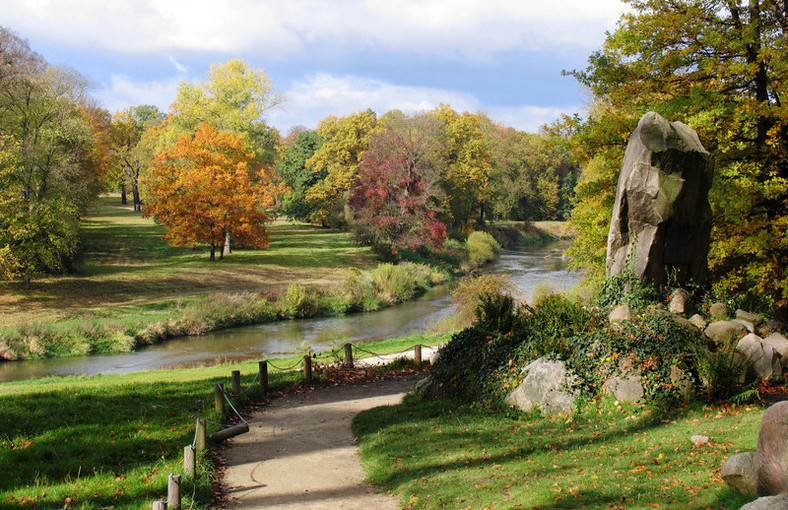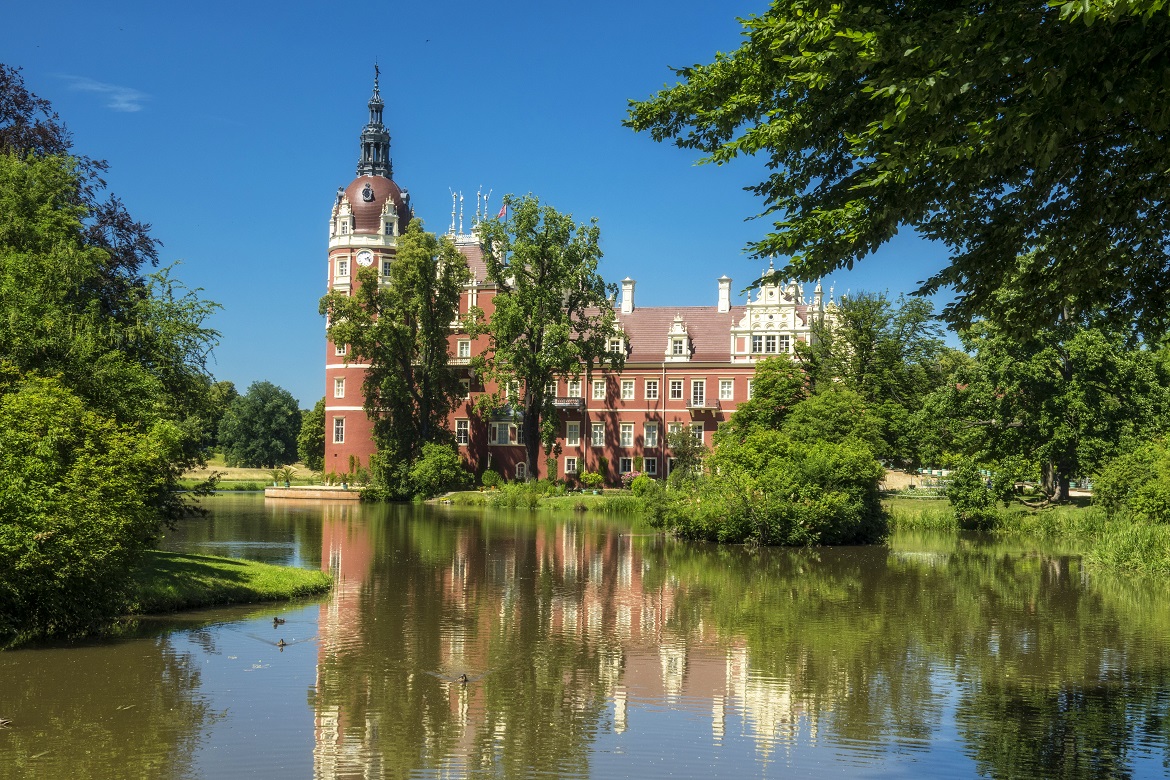Muskauer Park
Muskauer Park
The landscape park of the eccentric Prince Hermann Ludwig Heinrich von Pückler-Muskau in Bad Muskau, known on the Polish side as the Mużakowski Park in Łęknica, is one of the most outstanding achievements in European landscape architecture of the 19th century.
The park extends along both sides of the border river Lusatian Neisse, near the Łęknica – Bad Muskau border crossing. On the German side lies the smaller but more urbanised portion of the park covering an area of 200 ha while the Polish shore hosts 800 ha.
On May 1st of 1815, 30 year old Hermann von Pückler, owner of Muskau estates for four years, announced in an open letter to the citizens of the city of Muskau that he wishes to create a naturalistic park in the scenic area where the Neisse cuts through the terminal moraine called the Łuk Mużakowa (German: Muskauer Faltenbogen). The sole fact that the magnate informed his subjects of his plans, before proceeding, proved his extraordinary personality.
Herman von Pückler’s park was designed to illustrate an ideal connection between nature, culture, technique and spirit.
In the spring of 1817, the planting of 800,000 trees and 42,000 bushes begins, the route of the Neisse is changed and… an entire riverside village was moved because it interfered with the concept of the park. In order to raise funds for the garden works, the prince marries an older and rich woman only to formally divorce her a few years later to look for another fortune to finance the garden’s maintenance. His search ended without success.
Due to the lack of financial backing not all of the count’s plans – and since 1822, with an extra sum of 4000 „Prince von Pückler-Muskau’s” Thalers– were realized. As a novelty enthusiast and eccentric, he loudly expressed his democratic sympathies and published books under his own name. His most significant title is „Andeutungen über Landschaftsgärtnerei” („Thoughts on Landscape Gardening”), frolm 1834, a handbook highly valued everywhere outside Prussia. The prince travelled much and his travel journals, read with flushed faces, even by a master of the pen like Johann Wolfgang von Goethe himself, are a valuable heritage of German literature.
The prince was a known for his scandals and revolt against social norms, but as he once said:
„Wer mich ganz kennenlernen will,
muß meinen Garten kennen,
denn mein Garten ist mein Herz.”
„Who desires to get to know me inside-out,
must learn about my garden,
as my garden is my heart.”
In the mid 1840s, the prodigal prince went almost bankrupt and sold the park to Prince Frederik of the Netherlands. The new owner was also an advocate of his predecessors thought, and thanks to him the park areas were significantly expanded. The last pre-war owners of the park, the von Arnim counts, rendered the central part of the park a nature preserve.
Prince Hermann Ludwig Heinrich von Pückler remained an eccentric till the very end. He had ordered for instance, that after death, his body was to be dissolved in acid and poured into a flowery pyramid in the gardens of the Branitz castle, only because cremation was legally forbidden. He died there on February the 4th, 1871, at the age of 86.
After 1945, the park was divided into the left-bank German part and the right-bank Polish part. On July 2nd, 2004, the Muskauer Park was entered into the UNESCO list of World Heritage Sites.
Currently, both parts of the park are connected by a border crossing and a wooden bridge on the Lusatian Neisse. In line with the concept of its creator, the left-bank portion of the park, now in Germany, is more developed while the right-bank, currently in Poland, is the landscape part of the park.
Occupying more than 1700 acres, it’s one of the largest landscape parks in Europe. It stretches on both sides of the Nysa Łużycka River that constitutes the Polish-German state border. The larger part of the park (over 1200 acres) is located on the Polish side, while the German part occupies the neighborhood of Bad Muskau (Mużaków).
Prince Hermann Pückler-Muskau, the leading expert and father of German landscape parks, founded the park in the early 19th century. Inspired by English gardens, he transformed his family residence into unusual parkland. It was skillfully arranged in the natural valley with the residential buildings erected on diverse slopes and high terraces, all surrounded by gardens featuring rich architectural and floral details. The well-known architect Karl Friedrich Schinkel designed some buildings. Other artists and planners also contributed to the final result of the project. The group included the painter August Schirmer and the English landscape designer John Adey Repton. In order to create picturesque park scenery, an artificial river branch was created.
Thanks to the careful preservation of the original parkland by the subsequent owners such as for example Prince Frederick of the Netherlands, the Muskauer landscape retained its original character.
After WWII, the new Polish-German state border divided the Mużaków/Muskauer Landscape Park into two parts. The Polish and German authorities started the renewal program in the 1980s. This project has become a unique example of fruitful bilateral cooperation in the field of protection and conservation of cultural landscape.





